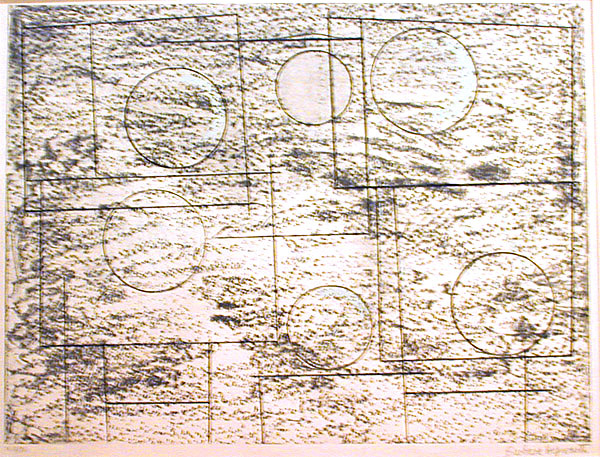Best known as a sculptor, Hepworth has made a number of prints as well. Hepworth's works are to be found in many important collections of modern art. What follows is taken verbatim from the National Museum of Women in the Arts' biography of the artist:
Barbara Hepworth, along with Henry Moore and Ben Nicholson, was at the center of a group of artists who created a revolutionary new approach to European abstract sculpture of the 1930s. Characterized by highly simplified, organic forms, with affinities to the work of Moore and Hans Arp, Hepworth's abstractions are imbued with a dignified presence that has often been compared with the serene power of classical sculpture.
Born in Yorkshire, England, Hepworth's family encouraged her talents from an early age and provided her every educational opportunity. Hepworth first attended the Leeds School of Art in 1920, where she became interested in the sculptural interplay of mass and negative space. The following year, she enrolled in the Sculpture School of the Royal College of Art in London. While at the College, she became friendly with fellow student Henry Moore and began a working relationship that would be of great significance to both artists' oeuvres throughout their careers. Upon graduating in 1924, Hepworth was granted a scholarship to travel and study painting and sculpture in Siena, Florence, and Rome. In Italy she experimented with direct carving techniques, which obviated the need for preliminary maquettes. The freedom of this approach gave her a new confidence in her abilities to bring out the best in her materials.
The 1930s was a period of great discovery for Hepworth. Now married to fellow sculptor Ben Nicholson, Hepworth traveled to Paris and visited with artists including Pablo Picasso, George Braque, Piet Mondrian, Jean Arp, and Constantin Brancusi. While there, she developed an affinity for geometric and biomorphic abstraction and she and Nicholson joined the Association Abstraction-Création before leaving Paris in 1933. This international connection to abstract art was strengthened in the mid-1930s through her, Nicholson's, and Moore's association with important artists such as Mondrian, Naum Gabo, and Làszló Moholy Nagy.
Beginning in the early 1930s, Hepworth's sculpture developed steadily toward organic, abstracted shapes with a powerful sense of being. In 1931, particularly, Hepworth created an alabaster work entitled Pierced Form, in which a hole was carved through the center of the sculpture. As scholar Alan Wilkinson points out, by creating this abstract, negative space, Barbara Hepworth inaugurated one of the most important formal features of her and Henry Moore's subsequent work (Alan G. Wilkinson, "The 1930s: Constructive Forms and Poetic Structure," in Barbara Hepworth: A Retrospective [London: Tate Gallery Publications, 1994], 37). Although it would be several years before Hepworth returned to this device, it soon became a hallmark of her style. Thirty years later, in the National Museum of Women in the Art's alabaster, Figure (Merryn), 1962, Hepworth was still using the central void to great effect in this beautifully carved sculpture whose softly curving shapes evoke a wealth of allusions to the female form. As the artist once stated,"...especially in sculpture,...there is a whole range of formal perception belonging to feminine experience. So many ideas spring from an inside response to form; for example, if I see a woman carrying a child in her arms, it is not so much what I see that affects me, but what I feel within my own body....It may be that the sensation of being a woman presents yet another facet of the scuptural idea."(Wilkinson, Cornwall and the Sculpture of Landscape: 1939-1975, 95)
Barbara Hepworth received numerous public commissions and awards throughout her career, including the Grand Prix at the São Paulo Bienal in 1959. She became a Dame Commander of the British Empire in 1965 and was lauded as a major figure in the international art world at the time of her death in 1975.
Bibliography: Ronald Alley, Barbara Hepworth (London: Tate Gallery, 1968); Dore Ashton, Barbara Hepworth "Conversations"(NY: Marlborough Gallery, 1974); Alan Bowness, Barbara Hepworth. Drawings from a Sculptor's Garden (NY: Praeger, 1967); Alan Bowness, The Sculpture of Barbara Hepworth 1960-1969 (NY: Praeger 1971); Sally Festing, Barbara Hepworth: A Life of Forms (London: Viking, 1995); Mathew Gale and Chris Stephens, Barbara Hepworth. Works in the Tate Gallery Collections and the Barbara Hepworth Museum, St Ives (London: Tate Gallery, 1999); Barbara Hepworth, Barbara Hepworth 1903-1975: 50 Sculptures from 1935-1970 (London: Gimpel Fils, 1975); Barbara Hepworth, Barbara Hepworth Ratrospective Exhibition 1927-1954 (London: Whitechapel Gallery, 1954); A. M. Hammacher, Barbara Hepworth (NY: Thames-Hudson, 1987); J.P. Hodin. Barbara Hepworth (London: Lund Humphries, 1961); Bryan Robertson, Barbara Hepworth: An Exhibition of Sculpture from 1952-1962 (London: Whitechapel Art Gallery, 1962); Alan G. Wilkinson, Barbara Hepworth: The Art Gallery of Ontario Collection (Toronto: Art Gallery of Ontario, 1991), Alan G. Wilkinson & Penelope Curtis, Barbara Hepworth A Retrospective (London: Tate Gallery/Art Gallery of Ontario, 1995); Alan G. Wilkinson & Penelope Curtis, Barbara Hepworth A Pictorial Autobiography (NY: The Tate Gallery, 1985).
|
|
